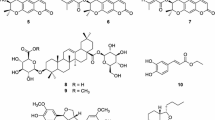Abstract
Garcinia mangostana L. (mangosteen) is a tropical fruit that has been used for medicinal purposes in Southeast Asia for centuries. With an interest in its applications to treat infection, we sought to investigate the bioactive constituents of mangosteen and identified the phenolic compound procyanidin B2 from the mangosteen pericarp by examining lipopolysaccharide (LPS) binding capacity. The LPS binding and neutralization activities of procyanidin B2 were determined by a combination of biophysical and in silico techniques. The affinity of procyanidin B2 to LPS was 1.61 × 10–5 M. Procyanidin B2 significantly neutralized LPS and selectively inhibited the LPS-induced release of tumor necrosis factor (TNF)-α from RAW264.7 cells in a dose-dependent manner. Binding thermodynamics revealed favorable hydrogen bonding and hydrophobic interactions between procyanidin B2 and LPS. Molecular simulations suggested that hydrogen bonding and hydrophobic interactions were involved in the binding process. These findings have, for the first time, shed light on the anti-inflammatory properties of procyanidin B2 through LPS binding and neutralization and provided a promising lead for the development of antiendotoxin agents.





Similar content being viewed by others
Data Availability
The datasets supporting the conclusions of this article are included within the article.
Abbreviations
- LPS:
-
Lipopolysaccharide
- PMB:
-
Polymyxin B
- ITC:
-
Isothermal titration calorimetry
- TNF-α :
-
Tumor necrosis factor-α
- HPLC:
-
High performance liquid chromatography
- LC–ESI–MS:
-
Liquid chromatography-electrospray ionization-mass spectrometry
- PBS:
-
Phosphate-buffered saline
- ELISA:
-
Enzyme-linked immunosorbent assay
- MTT:
-
Methyl thiazolyl tetrazolium
- KDO:
-
3-deoxy-D-manno-octulosonate
References
Ovalle-Magallanes B, Eugenio-Pérez D, Pedraza-Chaverri J (2017) Medicinal properties of mangosteen (Garcinia mangostana L.): a comprehensive update. Food Chem Toxicol 109:102–122. https://doi.org/10.1016/j.fct.2017.08.021
Gutierrez-Orozco F, Failla ML (2013) Biological activities and bioavailability of mangosteen xanthones: a critical review of the current evidence. Nutrients 5:3163–3183. https://doi.org/10.3390/nu5083163
Obolskiy D, Pischel I, Siriwatanametanon N, Heinrich M (2009) Garcinia mangostana L.: a phytochemical and pharmacological review. Phytother Res 23:1047–1065. https://doi.org/10.1002/ptr.2730
Benatrehina PA, Pan L, Naman CB, Li J, Kinghorn AD (2018) Usage, biological activity, and safety of selected botanical dietary supplements consumed in the United States. J Tradit Complement Med 8:267–277. https://doi.org/10.1016/j.jtcme.2018.01.006
Tang YP, Li PG, Kondo M, Ji HP, Kou Y, Ou B (2009) Effect of a mangosteen dietary supplement on human immune function: a randomized, double-blind, placebo-controlled trial. J Med Food 12:755–763. https://doi.org/10.1089/jmf.2008.0204
Kondo M, Zhang L, Ji H, Kou Y, Ou B (2009) Bioavailability and antioxidant effects of a xanthone-rich Mangosteen (Garcinia mangostana) product in humans. J Agric Food Chem 57:8788–8792. https://doi.org/10.1021/jf901012f
Xie Z, Sintara M, Chang T, Ou B (2015) Daily consumption of a mangosteen-based drink improves in vivo antioxidant and anti-inflammatory biomarkers in healthy adults: a randomized, double-blind, placebo-controlled clinical trial. Food Sci Nutr 3:342–348. https://doi.org/10.1002/fsn3.225
Shan T, Ma Q, Guo K, Liu J, Li W, Wang F, Wu E (2011) Xanthones from mangosteen extracts as natural chemopreventive agents: potential anticancer drugs. Curr Mol Med 11:666–677. https://doi.org/10.2174/156652411797536679
Watanabe M, Gangitano E, Francomano D, Addessi E, Toscano R, Costantini D, Tuccinardi D, Mariani S, Basciani S, Spera G, Gnessi L, Lubrano C (2018) Mangosteen extract shows a potent insulin sensitizing effect in obese female patients: a prospective randomized controlled pilot study. Nutrients 10:586. https://doi.org/10.3390/nu10050586
TousianShandiz H, Razavi BM, Hosseinzadeh H (2017) Review of Garcinia mangostana and its xanthones in metabolic syndrome and related complications. Phytother Res 31:1173–1182. https://doi.org/10.1002/ptr.5862
Sakagami Y, Iinuma M, Piyasena KG, Dharmaratne HR (2005) Antibacterial activity of alpha-mangostin against vancomycin resistant Enterococci (VRE) and synergism with antibiotics. Phytomedicine 12:203–208. https://doi.org/10.1016/j.phymed.2003.09.012
Xinchuan Z, Xiuying X, Shanquan F, Yimin Z (2011) Study on anti-lipopolysaccharide compounds from Garcinia mangostana L. J C Univ Technol 25:33–39. https://doi.org/10.3969/j.issn.1674-8425-B.2011.04.007
Jiang Z, Hong Z, Guo W, Xiaoyun G, Gengfa L, Yongning L, Guangxia X (2004) A synthetic peptide derived from bactericidal/permeability-increasing protein neutralizes endotoxin in vitro and in vivo. Int Immunopharmacol 4:527–537. https://doi.org/10.1016/j.intimp.2004.02.004
Trott O, Olson AJ (2010) AutoDock Vina: improving the speed and accuracy of docking with a new scoring function, efficient optimization, and multithreading. J Comput Chem 31:455–461. https://doi.org/10.1002/jcc.21334
Rodríguez-Morgado B, Candiracci M, Santa-María C, Revilla E, Gordillo B, Parrado J, Castaño A (2015) Obtaining from grape pomace an enzymatic extract with anti-inflammatory properties. Plant Foods Hum Nutr 70:42–49. https://doi.org/10.1007/s11130-014-0459-0
Fourati M, Smaoui S, Hlima HB, Elhadef K, Braïek OB, Ennouri K, Mtibaa AC, Mellouli L (2020) Bioactive compounds and pharmacological potential of pomegranate (Punica granatum) seeds - a review. Plant Foods Hum Nutr 75:477–486. https://doi.org/10.1007/s11130-020-00863-7
Zhang WY, Liu HQ, Xie KQ, Yin LL, Li Y, Kwik-Uribe CL, Zhu XZ (2006) Procyanidin dimer B2 [epicatechin-(4beta-8)-epicatechin] suppresses the expression of cyclooxygenase-2 in endotoxin-treated monocytic cells. Biochem Biophys Res Commun 345:508–515. https://doi.org/10.1016/j.bbrc.2006.04.085
Thomas CJ, Surolia A (1999) Kinetics of the interaction of endotoxin with polymyxin B and its analogs: a surface plasmon resonance analysis. FEBS Lett 445:420–424. https://doi.org/10.1016/s0014-5793(99)00150-7
Howe J, Andrä J, Conde R, Iriarte M, Garidel P, Koch MH, Gutsmann T, Moriyón I, Brandenburg K (2007) Thermodynamic analysis of the lipopolysaccharide-dependent resistance of gram-negative bacteria against polymyxin B. Biophys J 92:2796–2805. https://doi.org/10.1529/biophysj.106.095711
Mares J, Kumaran S, Gobbo M, Zerbe O (2009) Interactions of lipopolysaccharide and polymyxin studied by NMR spectroscopy. J Biol Chem 284:11498–11506. https://doi.org/10.1074/jbc.M806587200
Funding
This study was funded by the National Natural Science Foundation of China (grant No.: 81803394).
Author information
Authors and Affiliations
Corresponding author
Ethics declarations
Conflicts of Interest
The authors declare that they have no conflicts of interest.
Additional information
Publisher's Note
Springer Nature remains neutral with regard to jurisdictional claims in published maps and institutional affiliations.
Supplementary Information
Below is the link to the electronic supplementary material.
Rights and permissions
About this article
Cite this article
Zheng, X., Yang, Y., Lu, Y. et al. Affinity-Guided Isolation and Identification of Procyanidin B2 from Mangosteen (Garcinia mangostana L.) Rinds and its In Vitro LPS Binding and Neutralization Activities. Plant Foods Hum Nutr 76, 442–448 (2021). https://doi.org/10.1007/s11130-021-00920-9
Accepted:
Published:
Issue Date:
DOI: https://doi.org/10.1007/s11130-021-00920-9




